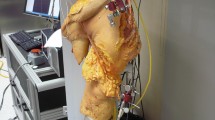Abstract
Preserving both cruciate ligaments in unicondylar knee arthroplasty likely provides more normal knee mechanics and contributes to enhanced patient function. It follows that preserving both cruciate ligaments with total knee arthroplasty should provide functional benefit compared to arthroplasty sacrificing one or both cruciates. The purpose of this study was to compare knee kinematics in patients with optimally functioning cruciate-preserving medial unicondylar and bi-unicondylar arthroplasty to determine if knee motions differed. Eight consenting patients with seven medial unicondylar and five bi-unicondylar arthroplasties were studied using lateral fluoroscopy during treadmill gait, stair stepping, and maximum flexion activities. Patient-specific geometric models based on CT and CAD data were used for shape matching to determine the three-dimensional knee kinematics. Tibiofemoral contact locations were computed for the replaced compartments. Maximum flexion in kneeling was 135°±14° for unicondylar knees and 123°±14° for bi-unicondylar knees (p=0.22). For 0°–30° flexion during the stair activity, the medial condyle translated posterior 3.5±2.5 mm in unicondylar knees and 4.7±1.9 mm in bi-unicondylar knees (p>0.05). Lateral posterior translation was 5.0±2.3 mm in bi-unicondylar knees for 0°–30° flexion. From heel-strike to mid-stance phase, there was little tibial rotation, but unicondylar knees showed 1.5±1.6 mm posterior translation of the medial condyle, while bi-unicondylar knees showed 5.1±2.2 mm (p<<0.05). The bi-unicondylar knees showed 3.8±3.4 mm posterior lateral condylar translation. Preserving both cruciate ligaments in knee arthroplasty appears to maintain some basic features of normal knee kinematics. Knees with bi-unicondylar arthroplasty showed kinematics closer to motions observed in total knee arthroplasty, slightly less weight-bearing flexion, and greater dynamic laxity in gait than unicondylar knees. Despite kinematic differences, knees with unicondylar and bi-unicondylar arthroplasty can provide excellent functional outcomes in appropriately selected patients.




Similar content being viewed by others
References
Insall J, Walker P (1976) Unicondylar knee replacement. Clin Orthop (120):83–85
Goodfellow J, O’Connor J (1992) The anterior cruciate ligament in knee arthroplasty. A risk-factor with unconstrained meniscal prostheses. Clin Orthop (276):245–252
Svard UC, Price AJ (2001) Oxford medial unicompartmental knee arthroplasty. A survival analysis of an independent series. J Bone Joint Surg 83-B(2):191–194
Deschamps G, Lapeyre B (1987) Rupture of the anterior cruciate ligament: a frequently unrecognized cause of failure of unicompartmental knee prostheses. Rev Chir Orthop Reparatrice Appar Mot 73(7):544–551
Hernigou P, Deschamps G (2004) Posterior slope of the tibial implant and the outcome of unicompartmental knee arthroplasty. J Bone Joint Surg 86-A(3):506–511
Chassin EP, Mikosz RP, Andriacchi TP, Rosenberg AG (1996) Functional analysis of cemented medial unicompartmental knee arthroplasty. J Arthroplasty 11(5):553–559
Argenson JN, Komistek RD, Aubaniac JM, Dennis DA, Northcut EJ, Anderson DT, Agostini S (2002) In vivo determination of knee kinematics for subjects implanted with a unicompartmental arthroplasty. J Arthroplasty 17(8):1049–1054
Goodfellow JW, O’Connor J (1986) Clinical results of the Oxford knee. Surface arthroplasty of the tibiofemoral joint with a meniscal bearing prosthesis. Clin Orthop (205):21–42
Cloutier JM, Sabouret P, Deghrar A (1999) Total knee arthroplasty with retention of both cruciate ligaments. A nine to eleven-year follow-up study. J Bone Joint Surg 81-A(5):697–702
Andriacchi TP, Galante JO, Fermier RW (1982) The influence of total knee-replacement design on walking and stair-climbing. J Bone Joint Surg 64-A(9):1,328–1,335
Pritchett JW (1996) Anterior cruciate-retaining total knee arthroplasty. J Arthroplasty 11(2):194–197
Stiehl JB, Komistek RD, Cloutier JM, Dennis DA (2000) The cruciate ligaments in total knee arthroplasty: a kinematic analysis of 2 total knee arthroplasties. J Arthroplasty 15(5):545–550
Komistek RD, Allain J, Anderson DT, Dennis DA, Goutallier D (2002) In vivo kinematics for subjects with and without an anterior cruciate ligament. Clin Orthop (404):315–325
Insall JN, Dorr LD, Scott RD, Scott WN (1989) Rationale of the Knee Society clinical rating system. Clin Orthop (248):13–14
Banks SA, Hodge WA (1996) Accurate measurement of three-dimensional knee replacement kinematics using single-plane fluoroscopy. IEEE Trans Biomed Eng 43(6):638–649
Canny J (1986) A computational approach to edge detection, IEEE Trans PAMI 8(6):679–698
Tupling S, Pierrynowski M (1987) Use of Cardan angles to locate rigid bodies in three-dimensional space. Med Biol Eng Comput 25(5): 527–532
Scott RD, Cobb AG, McQueary FG, Thornhill TS (1991) Unicompartmental knee arthroplasty. Eight- to 12-year follow-up evaluation with survivorship analysis. Clin Orthop (271):96–100
Bellemans J, Banks S, Victor J, Vandenneuker H, Moermans A (2002) Fluoroscopic analysis of deep flexion kinematics in total knee arthroplasty: the influence of posterior condylar offset. J Bone Joint Surg 84-B:50–53
Banks SA, Bellemans J, Nozaki H et al (2003) Knee motions during maximum flexion in fixed and mobile-bearing arthroplasties. Clin Orthop 410:131–138
Iwaki H, Pinskerova V, Freeman MAR (2000) Tibio-femoral movement. 1. The shapes and relative movements of the femur and tibia in the unloaded cadaver knee. J Bone Joint Surg 82-B:1189–1195
Hill PF, Vedi V, Williams A, Iwaki H, Pinskerova V, Freeman MAR (2000) Tibiofemoral movement. 2. The loaded and unloaded living knee studied by MRI. J Bone Joint Surg 82-B:1,196–1,198
Blankevoort L, Huiskes R, de Lange A (1988) The envelope of passive knee joint motion. J Biomech 21(9):705–720
Banks SA, Markovich GD, Hodge WA (1997) The mechanics of knee replacements during gait. In vivo fluoroscopic analysis of two designs. Am J Knee Surg 10(4):261–267
Banks SA, Hodge WA (2004) 2003 Hap Paul Award paper of the International Society for Technology in Arthroplasty. Design and activity dependence of kinematics in fixed and mobile bearing knee arthroplasties. J Arthroplasty 19(7):809–816
Acknowledgements
This study was sponsored by a project grant from Centerpulse Orthopedics Ltd, a Zimmer Company, Winterthur, Switzerland. The authors thank The BioMotion Foundation and the University of Florida for additional financial support. The authors thank Aarti Asnani, Anne Banks, Emily Downs, Lawrence McKinney, and Haseeb Rahman for their assistance with data processing.
Author information
Authors and Affiliations
Corresponding author
Rights and permissions
About this article
Cite this article
Banks, S.A., Fregly, B.J., Boniforti, F. et al. Comparing in vivo kinematics of unicondylar and bi-unicondylar knee replacements. Knee Surg Sports Traumatol Arthrosc 13, 551–556 (2005). https://doi.org/10.1007/s00167-004-0565-x
Received:
Accepted:
Published:
Issue Date:
DOI: https://doi.org/10.1007/s00167-004-0565-x




